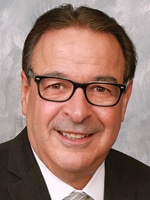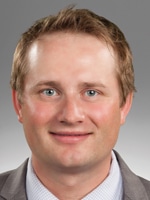Clark Day, I assume you’ve recovered from the basketball testing you were doing a couple of months ago. What’s the vaccination situation in Indianapolis?
Clark Day, VP of system laboratory services, Indiana University Health: Yes, we made it through the NCAA tournament and performed 28,300 tests in three weeks. Only 15 positives, which was great. We did variant testing on those specimens, and eight of the 14 we were able to test were U.K. and four of the specimens were of the variant that’s circling in the New York area.
About a third of the population of Indiana is vaccinated.
Diana Kremitske, what’s going on at Geisinger?
Diana Kremitske, MS, MHA, MT(ASCP), VP, Diagnostic Medicine Institute, Geisinger, Danville, Pa.: About 70 percent of our employees are fully vaccinated at this point. We’re still encouraging those who are on the fence. Our organization has been doing a lot in educating about the vaccine, not only for employees but also for the community.
We’re just starting to validate our variant testing and have run 20 random samples. We’re seeing the U.K. and New York variants.
You’ve all in the past few months expressed anxiety and concern about labor issues in the laboratory. Sam Terese, tell us about your laboratory workforce and labor situation at Alverno.
Sam Terese (Alverno): I spent most of the morning today in a dialogue about that. We are seeing significant shortages in several of our markets and it’s at the point where we think a couple of things have happened. There’s been an exodus of sorts: people leaving the field, a little burned out, a little fearful, and we’ve had some of that. The Alverno Laboratories system has a fairly young workforce relative to that of others, so retirement is not a big issue. In the nontechnical labor pool, we see a lot of people scheduling interviews and not showing up, or they get hired and don’t show up. Some of that may be related to government incentive programs and extreme competition for those individuals.
In spring of next year, we hope to open our third school of medical technology in the Chicago market to drive the labor pool. We already have two in Indiana plus a histotechnology program, and the school in Chicago will be our first in Illinois. Over the long term we’re going to have to drive the pool.

Terese
You’ll teach and grow your own and retain them and set them on a career path?
Sam Terese (Alverno): Yes, and we do that with histotechnologists. We are finding our processing staff and turn them into histotechs. They do a great job. We graduate 12 to 14 a year. And I failed to mention we have an MLT program we also sponsor out of northwest Indiana to help drive the technical labor pool. We also have pretty structured programs for taking biology-degreed–level people and training them to be techs as well. We’ve accepted that if we’re going to solve the issue, we’ll have to create the workforce. They’re not coming to us in any other way.
We have a lot of automation throughout the system, and we’re launching additional projects. All the operational things we can do from an efficiency perspective are still in play, but they’re not going to get us all the way home.
Diana Kremitske (Geisinger): We’re seeing the same, especially with our phlebotomy workforce, and I think the solution is not only going to become grow our own but also increase the rate of pay. And it’s going to impact the rates of pay for all the other laboratory roles because you start to run into compression issues throughout the workforce.
Our organization is seeing this not only in phlebotomy but also with other workers such as environmental services workers. There’s been a lot of communication about referral bonuses for these positions throughout our organization, as well as sign-on bonuses. What will be the rate of pay moving forward for laboratory professionals in all positions is going to be a key conversation.
Julie Hess, you’ve talked about labor difficulties at AdventHealth. Would you like to comment?
Julie Hess, executive director, laboratory services, AdventHealth, Orlando, Fla.: As soon as we think we have a wage solution for our entry-level staff, we are outbid by someone else. In central Florida we have found that Amazon distribution centers are paying well and people who don’t want to stay in health care are taking that entry-level position or other retail options. As soon as we increase our minimum wage, someone else out there is looking more attractive, maybe with benefits or with sign-on pay—different things. It’s a challenge to know if we can keep increasing the minimum wage and adjust the compression or if this is something we should give time to settle out. Maybe with the temporary sign-on bonus we can help alleviate the problem short term.
As Sam said, we too feel we have to grow our own resource, especially licensed employees. So I’ve started talking to a third university to try to develop another local program. The gap is not closing fast enough to prevent burnout. We have a lot of dedicated laboratory employees who have been with AdventHealth for years, and I feel bad asking them not to retire at 70-plus years old. They will retire someday soon, but we need new people to join us in this field. It’s a real challenge now in our area.
Terry Dolan, can you comment on the labor issue as you see it at RML, or on the COVID situation in Tulsa and across the state?
Terrence Dolan, MD, president, Regional Medical Laboratory, Tulsa, Okla.: We are seeing the positive rates for COVID-19 PCR level off. We’re doing quite a few antibody studies and we’ve had three patients who ended up in the hospital who were fully vaccinated and came down with COVID-19. We checked their antibodies; they were extremely low. Many doctors have reached out to me and we’re starting to test many of those who have underlying disorders. I think there’s real merit to that as time goes on. The spike protein, which gives us neutralizing antibody at least in correlation, seems to indicate that.
Oklahoma’s immunizations are going well; about a third are fully vaccinated. We are offering vaccinations to anyone who walks in the door as well as out of staters.
The workforce situation is similar to that of others. A hospital in Tulsa closed recently and that has given us a temporary increase in personnel. We’re seeing a lot of closures of community hospitals in the rural areas in this state and in Kansas, Arkansas, Texas, and elsewhere. Those workers start commuting into the city. That’s helped us as well.
We had a real shortage of phlebotomists in our hospitals. Techs are always an issue. We are open to any way we can participate with our colleges and universities in our surrounding area. We provide training to people who need an internship type of program. We have phlebotomist and med tech programs. We’re doing everything we can and the closures are helping. Our histology work picked up bigtime and we ran into real shortages there, but for whatever reason we’re starting to get a lot of takers in the past week and starting to fill positions.

Ingemansen
It’s a good sign. Dan Ingemansen, what is your labor situation in Sioux Falls?
Dan Ingemansen, senior director, Sanford Health, Sioux Falls, SD: At Sanford, we have 40 open laboratory positions, most requiring technical degrees. Sanford has two MLS programs, one in Sioux Falls and one in Fargo, which produce 20 MLS candidates per year. Knowing hiring will remain an ongoing challenge, I’ve challenged my team to review every job duty and we asked: Does that job function require a technical degree? If not, we will look to train a nontechnical associate. Another opportunity we continue to review is the on-site laboratory menu at our hospital and clinics. Like other Compass members, we’re not getting applicants and must think differently to continue providing high-quality services.
Yes, I do think new thinking will be needed over the long term to solve some of this problem. Jim Crawford, would you care to comment on anything you’ve heard?
James Crawford, MD, PhD, professor and chair, Department of Pathology and Laboratory Medicine, and senior VP of laboratory services, Northwell Health, New York: On the workforce topic, you may be aware that New York State has a strict vertical approach when it comes to technician and technologist training and certification: requiring state review and approval, or not, of course-hour work and the taking of a New York State certification examination regardless of out-of-state experience and certification. Thanks in part to the COVID crisis and the light shone on our laboratory workforce over the past year, the New York State Clinical Laboratory Association is working closely with Albany to try to rectify something that should have been fixed long ago: accepting National Accrediting Agency for Clinical Laboratory Sciences-approved degreed training and ASCP certification from out of state.
Since the beginning of the COVID pandemic, laboratory leadership of the academic medical institutions of New York State have been working together as a consortium [Crawford JM, et al. Acad Pathol. Jan. 2021]. We just completed a survey on what consortium institutions are facing as regard to current workforce shortages and what their ideal workforce size should be. For the 12 institutions that reported in, the findings are strikingly consistent: We are running at about 88 to 90 percent staffing in our clinical laboratories. When you think about a three-shift staffing requirement, seven days a week, and the subspecialized workstations that need to be staffed, it’s not hard to feel that the gaps loom large on a 24-hour cycle. And this is before we factor in the workplace stress incurred by personnel needing to work overtime and the not uncommon need for individuals in our workforce to work two jobs at different institutions.
This information was sought by the New York State Clinical Laboratory Association to help fuel not just the advocacy process but also impress upon state regulators the urgency of the need to change the regulations. I am grateful to the institutions that reported in—Northwell included—since we are competing in the same job market for the same potential employees. I don’t know if these New York State data are reflective of other states in the country, but what is striking to me is the consistency across area institutions. That’s basically hot off the press.
 CAP TODAY Pathology/Laboratory Medicine/Laboratory Management
CAP TODAY Pathology/Laboratory Medicine/Laboratory Management
